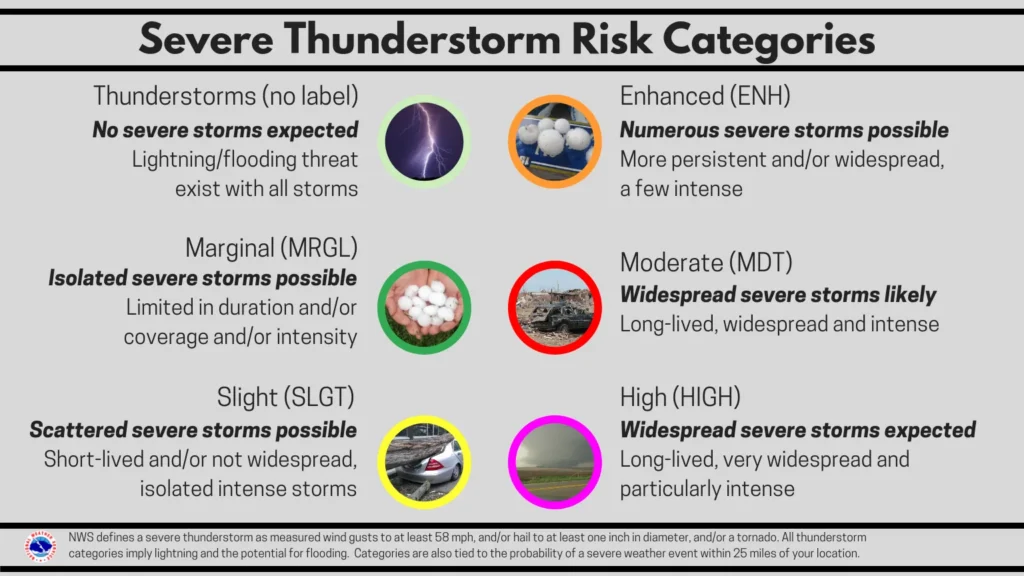Hey there, weather watchers! Today is a First Alert Weather Day, which means we need to pay close attention to the skies. This afternoon and evening could bring some serious storms to our area, so it’s important to know what to expect. As the sun heats up, conditions will become just right for thunderstorms and even tornadoes! From heavy rain to strong winds and hail, all kinds of severe weather might pop up. Let’s dive into what this means for us today and how we can stay safe!
| Category | Details |
|---|---|
| Event | First Alert Weather Day – Severe Storm Risk |
| Date | February 12, 2025 |
| Timing | Afternoon to Midnight |
| Weather Conditions | Passing showers, brief downpours |
| Severe Weather Risks | Tornadoes, heavy rain, gusty winds, hail |
| Peak Risk Time | Noon until Midnight |
| Tornado Watch | Likely to be issued later today |
| After Effects | Cooler conditions expected overnight |
| Next Severe Weather Risk | Late Saturday |
Understanding First Alert Weather Days
First Alert Weather Days are announced by meteorologists to warn people about severe weather conditions. This alert helps everyone prepare for dangerous storms that may bring heavy rain, strong winds, or even tornadoes. Knowing about these alerts means you can take steps to keep safe, like staying indoors during storms or having an emergency kit ready. It’s important to pay attention when you hear about a First Alert Weather Day on the news or through weather apps.
On a First Alert Weather Day, the weather can change quickly. For instance, the storms may start with just a few light showers, but as the day goes on and it gets warmer, major storms can develop. When you hear about these alerts, it’s a reminder to check the weather forecast regularly. Understanding what a First Alert Weather Day means can help you stay safe and informed when severe weather hits your area.
What to Expect During Severe Storms
When severe storms arrive, you might experience a variety of weather conditions. These can include heavy rain, strong winds that can blow things around, and even hail that can damage cars or windows. Sometimes, tornadoes can form, which are very powerful and dangerous. It’s crucial to stay inside and away from windows during these storms to keep yourself safe. Listening to weather updates can help you know what’s happening outside.
After the storms pass, the weather usually clears up, and you might notice cooler temperatures. Once the storms are gone, it’s important to check your surroundings for any damage. You might find fallen branches or debris. Staying safe means being cautious and knowing when it’s safe to go outside again. Always remember that understanding severe weather helps you be prepared and react appropriately when storms come.
Preparing for Severe Weather
Preparing for severe weather is essential for keeping yourself and your family safe. One of the best ways to prepare is to create an emergency kit. This kit should include things like water, non-perishable food, flashlights, and a first aid kit. Having a plan in place, like where to go during a tornado, is also very important. Make sure everyone in your family knows what to do when a severe storm warning is issued.
Additionally, staying informed about the weather can help you prepare for severe storms. You can check weather apps, listen to the radio, or watch TV for updates. Knowing when a First Alert Weather Day is announced allows you to take action ahead of time. Remember, it’s always better to be safe than sorry. Preparing for severe weather can make a big difference in keeping you and your loved ones safe.
Understanding Severe Storm Risks
Severe storm risks are associated with various atmospheric conditions that can lead to dangerous weather phenomena. As air temperature rises during the day, it creates instability in the atmosphere, which is conducive to severe storms. Early indications of such conditions often include increased humidity and wind patterns that suggest significant weather activity. Understanding these elements helps communities prepare for potential impacts and take necessary precautions.
Weather forecasts typically classify the severity of storms based on several factors, including wind speed, precipitation levels, and the potential for tornado formation. Meteorologists utilize advanced radar technology to monitor these conditions in real-time. By interpreting data accurately, they can issue timely alerts that allow residents to stay safe and informed, making it crucial for everyone to pay attention to First Alert Weather Days.
Preparing for Severe Weather
Preparation is key when severe weather is on the horizon. Residents should ensure they have an emergency plan in place, which includes knowing the safest areas in their homes, especially during tornado warnings. It’s also wise to have an emergency kit ready, stocked with essentials like water, non-perishable food, medications, and a flashlight. Staying informed through reliable weather sources can help people make quick decisions during severe weather events.
Additionally, it’s important to keep communication lines open with family and friends. Designate a meeting spot in case of evacuation, and ensure everyone knows how to access weather updates via mobile apps or local news. During severe storm forecasts, avoid unnecessary travel and stay indoors, particularly during peak storm hours. Taking these proactive measures can significantly increase safety for individuals and families.
Post-Storm Safety and Recovery
After severe storms pass, assessing the impact and ensuring safety is paramount. Check for downed power lines or damaged infrastructure before venturing outside. Authorities may issue safety advisories, so it’s essential to stay tuned to local news for updates. If there are any signs of flooding, avoid driving or walking through affected areas, as this can lead to dangerous situations.
Recovery can take time, especially if significant damage has occurred. Communities often come together to assist those affected by storms, providing resources and support. It’s vital to report any damage to local officials and insurance companies to expedite aid and recovery processes. Engaging with community recovery efforts can foster a sense of unity and resilience in the face of adversity.
The Importance of Weather Alerts
Weather alerts serve as vital communication tools during severe storm events. They provide timely and critical information that can save lives and property. Alerts can range from general storm warnings to specific advisories about tornadoes or flash floods, each designed to inform the public about immediate threats. By understanding the differences between these alerts, individuals can respond appropriately to protect themselves and their loved ones.
Moreover, awareness of weather alert systems fosters a culture of preparedness. Regularly checking weather updates, especially on days marked as First Alert Weather Days, can empower individuals to make informed decisions. Many communities have adopted mobile alert systems to ensure that everyone receives important notifications. Staying engaged with these resources can significantly enhance community safety during unpredictable weather events.
Frequently Asked Questions
What is a First Alert Weather Day?
A **First Alert Weather Day** is when the weather can be very dangerous. It means you should pay attention to weather updates and be prepared for storms.
Why is there a risk of severe storms today?
The risk of severe storms today is because of warm weather. As it gets hotter, conditions can create **strong storms** with heavy rain, wind, and even tornadoes.
What types of severe weather can happen during a storm?
During a storm, you might see:
– **Tornadoes**
– **Heavy rain**
– **Strong winds**
– **Hail**
Each of these can cause damage, so it’s important to stay safe!
What should I do if there’s a Tornado Watch?
If a **Tornado Watch** is issued, it means conditions are right for tornadoes. Stay indoors, listen to the news, and have a plan in case you need to find shelter.
How do storms form when it gets warmer?
When it gets warmer, the air heats up and rises. This can lead to clouds forming and storms developing, kind of like how steam builds up in a kettle!
What should I prepare for a severe storm?
To prepare for a severe storm, you should:
– Have a **flashlight**
– Keep **batteries** handy
– Store **water** and snacks
– Know where to go for safety.
Why do we need to watch the weather closely on stormy days?
Watching the weather closely helps you stay safe. You can know when to expect storms and make plans to protect yourself and your family from any danger.
Summary
The content discusses the declaration of a First Alert Weather Day due to increasing severe storm risks expected this afternoon and evening in New Orleans. It highlights that while morning conditions may bring only light showers, the risk for severe weather will escalate as the day progresses, peaking from noon to midnight. Various severe weather types are possible, including tornadoes, heavy rainfall, strong winds, and hail. Additionally, a Tornado Watch may be issued later in the day. The forecast indicates that conditions will improve overnight, leading to cooler weather later in the week, with another storm risk anticipated on Saturday.








